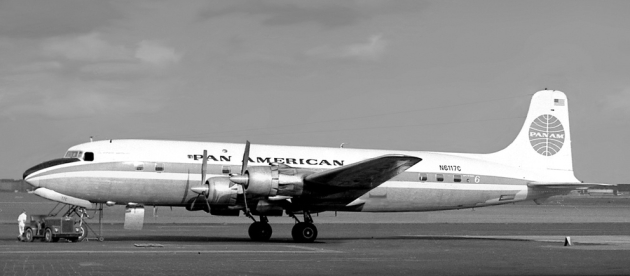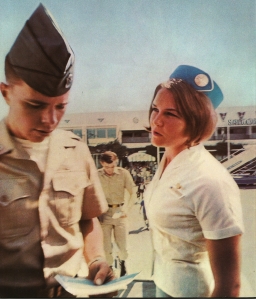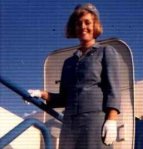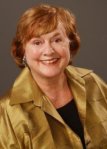Pan Am Series – Part XXXIV: R&R in Vietnam War
3 May 2014 12 Comments
Pan American’s Rest and Recuperation Airlift – Vietnam War

The DC-6B was used initially in the Rest and Recuperation Airlift. These aircraft were brought over from the Internal German Service in Berlin. (Ralf Manteufel photo)
It is well known that over the years Pan American World Airways’ Chief Executive Juan T. Trippe might have held differing views with respect to United States government policy toward his airline. However, notwithstanding his personal feelings, he always made his airline available for service to the country. This went back to the earliest days of the airline and carried on throughout its existence.
One of the biggest operations in support of the country was during the Vietnam War, when Pan American Clippers carried troops and cargo between home and the war. As noted in the 1965 Annual Report, Pan American was providing approximately “40 flights every week between California and Saigon for the support of the military”. In March 1966 Pan American helped boost morale when it began a massive airlift of troops between Vietnam and rest and recuperation areas initially in Southeast Asia and Japan, and later the addition of Australia and Hawaii. Pan American was, according to the 1967 Annual Report, “the only airline providing this service. . . .[and in] two years more than 500,000 round-trip passengers used the Rest and Recuperation Airlift. Each has enjoyed full First Class amenities on these flights”.
As government needs for airlift increased as the war progressed, the 1968 Annual Report highlighted the fact that operations in support of the military increased dramatically:
“Pan Am provided a larger portion than any other airline of civil airlift of medical supplies, matériel and personnel across the Pacific in support of the armed forces in Southeast Asia. As of March 1, 1969, approximately 12 percent of Pan Am’s long range jet fleet was assigned to military support services. [The airline’s] transpacific airlift provides up to six flights a day to Vietnam.
“Pan Am conducts the airlift of troops between Vietnam and rest-and-recuperation sites. Since the start of this program in March, 1966, Pan Am has carried more than 800,000 round-trip passengers on the Rest and Recuperation Airlift.
During the Tet offensive beginning February, 1968, Pan Am responded to the urgent request of the Department of Defense and assigned a total of 18 Boeing 707-321’s to the emergency airlift. Additional cargo and passenger expansion capability was also provided on regularly scheduled services.
“On July 1, in response to a Government request, Pan Am opened seven Sales/Service offices in Vietnam.”
Two former Pan American Flight Attendants (then Stewardess) worked on the R&R flights during 1967 – 1968 and generously share their experiences in the following two stories. The first, by Anne Sweeney, originally appeared in the Pan American Historical Foundation’s newsletter, Clipper:
“The tropical sun shone through the window of the DC-6 and on to the baby face of the young blond soldier sleeping off five days of R&R in the bars and brothels of Bangkok. His stubble was sparse and soft in the morning light.
“I moved to the next row- two brothers with Darth Vader shades and a shy, slight Puerto Rican kid. Their meals were always the same on the R&R flights – steak, home fries, green beans, fresh milk, ice cream – and ketchup. On everything but the ice cream.
“They were typical R&R passengers – young kids, from the ghettos, barrios and backwaters of America – LeRoy, Manuel, Billy Bob.
“Our Pan Am crews were based in Hong Kong and we worked these R&R flights, exclusively, flying troops from Saigon, Cam Rahn Bay and Da Nang to for five days of “Rest & Recuperation” in places like Bangkok, Singapore, Taipei and Hong Kong. In support of the war effort and to gain government favor, Pan Am organized and operated these flights for $1 a year plus costs. The aircraft were old DC-6s; propeller planes phased out from the company’s Berlin operation by new 727s.
“We did our best to make them comfortable on the flights – to chat, smile and bring extra milk or ice cream. The soldiers were polite and deferential. ‘Where are you from in the world, ma’am?’ The world was anywhere outside Vietnam; a country few of them knew existed until their draft boards set them straight.
“The plane started its approach into Cam Rahn Bay. Miles of blue and green water and beaches were covered from end to end with military equipment. Scrap metal, artillery, jeeps and tires rotted and rusted in the tropical heat. Cahn Rahn Bay was an Air Force Base. We unloaded one group of soldiers, the aircraft was cleaned and provisioned, another group quickly boarded and we were aloft, headed home to Hong Kong’s Kai Tak Airport. Landing at Kai Tak was actually more perilous than landing in Vietnam“My Christmas was waiting to begin across the harbor in a modern flat overlooking the South China Sea. It would be like no other Christmas for this small town girl from Rhode Island.
“When I got there, a Japanese Spruce tree would be hung with handmade ornaments, and Ah Nee, my houseboy, would be busy with preparations for Christmas Dinner. Ten people were coming – friends from Pan Am, my next-door neighbor, an Englishman I’d been seeing, plus friends of his from the British Navy whose ship was in port. There was room for more. I invited two young GI’s, Mike and Ted, from the flight.“As soon as we were off-duty I headed for the Star Ferry and home. I loved the ferry at sunset. Violet dusk settled over the harbor and the lights came up on both sides of the port. Behind me, in Kowloon, the white Colonial façade of the Peninsula Hotel glowed in the last light and the deck lamps of the luxury liner SS Rotterdam were lit. Junks, sampans, pleasure craft, tankers, and freighters, military ships from aircraft carriers to supply boats, plied the harbor or rested at its piers. Up ahead on the Hong Kong side, a portrait of Chairman Mao stared from the towers of the Bank of China..
“On the Peak, lights glimmered in the great houses of the Tai Pans and along the Tramway that slowly climbed the steep hills.“The Hong Kong Hilton yacht, Wan Fu, in full sail, glided by. A cocktail party was in progress; the well-heeled passengers, flying their colors of bright silks and navy blazers, sipping Tanqueray martinis and Tattinger Champagne.
“We docked, and within minutes, a taxi was speeding me up and over the hills and home for Christmas.
“The next morning was overcast, its chill mitigated by some of Ah Nee’s homemade and hot rice wine. Guest arrived at 2 – pilots, stewardess, naval officers and the two young soldiers from the plane. The Brits brought some very fine Scotch and Roger’s mother has sent a plum pudding from Fortnum’s. The festivities were interrupted briefly at 3 when Roger insisted we listen to the Queen’s Speech, broadcast at 3 o’clock on Christmas Day throughout the Commonwealth. Her Majesty’s high, clipped voice wished us all a Happy Christmas just before Ah Nee, who could cook in several languages, presented a perfect turkey with all the trimmings.
“In the midst of the meal, the phone rang. It was my father, calling me from Rhode Island. How was I, he asked. Had it been a lonely day? No, no, I assured him. We had made our own Christmas.
“‘You know what I always told you,’ he said, his voice cracking over the time zones and tears. ‘That there would always be cake and ale and Christmas.’
“Gathered around the table, strangers and friends, we found a glad holiday, however far from home. Thankfully, we didn’t know what the future held. Those at the table would scatter and lose touch. The war would be lost. Pan Am would one day fold its proud wings. The Queen would send her son to preside at the return of Hong Kong to China. One of the young soldiers would die on another holiday a few weeks later in what became known as the Tet Offensive, the Vietnamese Lunar New Year.
“But on that Christmas Day, all seemed merry and bright. Carols rang out. Toasts were raised to the season. The plum pudding flamed in a brandied glow. There was indeed, cake and ale and Christmas, and I knew then there always would be.”
A former Pan Am flight attendant, Anne Sweeney also worked in the corporate communications department at Pan American World Airways. She was based in Hong Kong from 1967-68, flying the company’s R&R flights for US troops, taking soldiers from Vietnam to cities throughout Asia. She is president of Anne Sweeney Public Relations in South Brunswick, NJ
The second story, by Dr. Helen Davey, is featured in the book Pan American World Airways – Aviation History Through the Words of its People:
“I’ll never forget my first glimpse of Vietnam. It was the spring of 1968, after the disastrous Tet Offensive had resulted in an escalation of the war. I was flying my first volunteer flight as a Pan Am stewardess into Saigon to pick up American soldiers and deliver them to their R & R’ (rest and recreation) destination. Glued to the airplane window as we approached Tan Son Nhut airport, I was astonished to see actual bomb craters and smoke rising from scattered skirmishes on the ground. I had to give myself a reality check: was this really me, and was I really seeing this, and were American men really being killed right below me? I thought I had seen it all on the nightly newscasts at home, but somehow I was shocked to see this vision of hell first hand.
“As we had been briefed, the pilots made the steepest descent I had ever experienced in an airplane. I remember thinking about all the stories of bullets being found in the fuselage of Pan Am airplanes, and the jokes about Pan Am pilots sitting on their manuals for a little extra protection while flying in and out of Vietnam. In my purse, I carried the paper that awarded Pan Am stewardesses Second Lieutenant in the U.S. Air Force status, which meant that under Geneva Convention rules we would be treated as officers in the event of capture. Used to providing elegant in-flight service to our passengers in a rather formal atmosphere, I was about to experience the most surreal flight I had encountered to date. We had been told that ‘almost nothing was by the book,’ but only the male purser on our flight and the pilots who had flown many flights to Vietnam knew what that meant.
“As we taxied around the airport, I felt overwhelmed to see the sheer numbers of war machines of all types buzzing around seemingly everywhere. As we swung the door open, the noise was deafening, and the hot humid air enveloped me, taking my breath away. Our stewardess uniforms were made of fabric that was supposed to be ‘all weather, which really meant that it was too hot in summer and too thin in winter. Add to that the fact that we were still required to wear stockings and girdles, and I think you can imagine our discomfort. As I stared out of the open door, I became aware of the pallets of aluminum coffins lined up on the tarmac – each one containing somebody’s precious husband or son or father or boyfriend or uncle or friend.
“I don’t think anything could have prepared me for the sight of the soldiers that boarded our airplane. I was expecting to see excited young men ready for a new adventure, laughing and joking with each other, and relieved to get away from the war. But as the men quietly filed aboard the airplane, I clearly saw the faces of trauma. Many were strangely quiet, with expressionless ‘masks’, and most of them stared at our ’round eyes’ as if trying to take in a bit of home. I had no idea how young these men would be, but I wasn’t expecting them to look like they should be in high school! Twenty-five at the time, I wasn’t used to being called ‘Ma’am,’ and I felt strangely old. I’m convinced that my experiences with these traumatized men helped fuel my later professional interest in the study of trauma.
“The Pan Am pilots, mostly ex-military men, felt deep empathy for these soldiers, and their announcements reflected it. And here’s where our very talented male purser came in. As funny as any stand-up comedian, he knew exactly how to handle these traumatized men. Totally throwing aside our traditional announcements, he used colorful language that I had never heard uttered on a Pan Am intercom. He spoke right to the men, as if he were waking them up from their nightmare. And he loved to tease the stewardesses! As we were doing our regular emergency demonstrations, we were supposed to point overhead to the forward, center, and aft life rafts in the ceiling. During the part where he was supposed to say ‘forward, center, and aft life rafts,’ he mixed it up and said, ‘aft, center, and forward.’ By rote, all of us stewardesses pointed out the rafts in their normal sequence. He said, ‘So you see, guys, our young ladies don’t seem to know their ‘forward’ from their ‘aft!’ The soldiers exploded in laughter, and the tone was set for helping to relieve these young men’s burdens for a short time. By the end of the flight, some of the soldiers seemed less robotic, and their eyes were coming alive.
“Nothing about this flight felt familiar. Several of the men got up and helped with the serving of meals, leaving us stewardesses with more time to talk to the homesick men. Some of them wanted to ask about what was happening at home, especially about the escalation of protests. One of them asked me to call his mother when I got home, which I did. They showed us pictures of family, children, girlfriends, and wives. They wanted to know all about our crew, where everybody was from ‘in the world.’ One Vietnam vet wrote about Pan Am stewardesses that we were ‘some of the sweetest, caring women I’ve ever known and need to be recognized for their contribution. Nurse, psychiatrist, mother, sister, daughter, girlfriend, confessor, sex object – they wore all the hats.’
“So hungry for a touch of home, their eyes pleaded for just a little conversation. I learned on that first flight that if anybody had gone to sleep due to exhaustion, we had to be very careful in waking them up; they would awaken in an extremely startled state, arms flailing, reaching for their imaginary guns. I didn’t realize at the time that I was witnessing Post Traumatic Stress Disorder, which might stay with them for the rest of their lives. I picked out one particularly vulnerable looking soldier who was very shy, and as we talked, I decided to become his pen pal. I knew that having a Pan Am stewardess as a pen pal would qualify any soldier to be regarded as a ‘rock star.’
“This was the first of four soldiers that I eventually agreed to have as pen pals. When I began to receive notices, one by one, that each one had been killed, I started to regard myself as a jinx and stopped writing letters. Now I regret this, but at the time it just became too painful for me to be able to put a face to the names of dying men.
“Music is where my memory of Vietnam lives, and this time of my life comes with its own special sound track; Creedence Clearwater Revival, The Doors, Buffalo Springfield, Jimi Hendrix, Jefferson Airplane, Marvin Gaye, Ike and Tina Turner, Bob Dylan, Crosby Stills & Nash, Otis Redding, the Animals, Aretha Franklin, and Edwin Star who sang ‘War’ (‘War! Huh! Good God, y’all! What’s it good for? Absolutely nothing!’) The music describes wartime — especially the ambivalence about this particular war — better than words can convey. When I hear it, I feel as if I were back there. I think that any of us Pan Am employees who flew into Vietnam feel that we, too, were a part of that war. At the time, many of our regular destination cities in Asia were teeming with American soldiers, and wherever there were American soldiers, there was the music, blaring and insistent.
“In a bizarre conclusion to my first flight to Vietnam, I asked the Captain if I could sit in the cockpit for landing. He said, ‘Of course.’ Again, since all rules were mostly suspended, the Captain decided to generously allow the engineer, who never really got to fly the airplane, to help with the landing. On final approach, just before touchdown, the left wing of the airplane dipped way too close to the runway. At the last moment, the Captain grabbed the controls back, and I think that every person in that airplane knew that we probably narrowly escaped disaster. Nobody in the cockpit spoke. I could tell that the blood had drained from the pilots’ faces, and the engineer was shaking
Trembling from what had just happened, I stumbled out of the cockpit. The purser was up to his old tricks, and was just waiting for me to step through the door. He had signaled to the men, and when I appeared, a soldier yelled, ‘Nice landing, Ma’am!’ Again, everyone exploded in laughter. After all, what was a little ‘near crash’ to them? These brave men were facing death every day anyway. I sat down by the purser on the jumpseat and said, ‘We were just in the middle of a battle, and we almost crashed!’ He replied with a phrase that I was to hear often:
“’Well, welcome to war!‘”
Dr. Helen Davey is a psychoanalyst and psychotherapist in private practice in West Los Angeles and a former Pan Am Stewardess. Her doctoral dissertation, A Psychoanalytic Exploration of the Fall of Pan American World Airways, is a study of the trauma experienced by Pan Am employees when the airline collapsed. She published an article entitled “The Effects of the Trauma of 9/11” for airline employees following the terrorist attack. She is a regular contributor to the Huffington Post.
Below is a YouTube Video of Pan American’s Rest and Recuperation Airlift:
For additional information about Pan American World Airways:
To learn more about the history of this pioneering airline, click on the title below for preview of
Pan American World Airways – Images of a Great Airline Second Edition.
This book is available on eBay .
Another excellent book is Pan Am – Personal Tributes to a Global Aviation Pioneer, which was published to commemorate the 90th Anniversary of Pan Am’s founding. It contains more than 80 stories written by former Pan Am employees and international media friends who had personal experience with many of Pan Am’s key events during its history. It is the perfect companion to Pan American World Airways – Images of a Great Airline Second Edition and can be purchased on Amazon.
Preview Pan American World Airways – Aviation History Through the Words of its People, which is available on Amazon.
For further information about the history of Pan American World Airways, visit: Pan Am Historical Foundation






Jamie;
I cried.
The two stew articles were superbly written.
Thanks, Van
Your series brought back many memories for me. I was a Pan Am flight attendant from 1969 to 1974, based out of SEA the first year and LAX the remainder.
In June of 1971 I met the love of my life in California exactly one month before he was to depart to spend a year in Vietnam. He had come to California to attend Vietnamese language school and my Pan Am roommate introduced us.
I flew MAC Charters for a year in order to see him in Vietnam when he was not out on river patrol. Once in awhile we actually got to see one another there! We got engaged in the first class lounge of a Pan Am 747 during a transit stop at Saigon in the fall of 1971. He drove a military jeep right out to the airplane.
I married my handsome young Navy Lt. on his R&R in Honolulu on February 11, 1972. We met once again, in Hong Kong, before his year in Vietnam was up. We have been married 42 years.
Thank you following my series and for sharing your story. It is great to hear from Pan Amers and read their their stories. Pan American was such a unique institution and I am hopeful, through the series and contributions from Pan Amers like yourself, that the legacy of the airline will carry on for generations to come. Interestingly enough, I was living in Los Angeles during your tenure there and made a couple of transpacific trips during that time on PA 747s….I, too, eventually became a Navy LT, although whether I was handsome is another question!
I was the only operations man in DaNang from 1966 to 1977. When I left Vietnam we had three other ops people and at least four maintence guys. I used to work over ten flights a day and lived in a leased house in downtown DaNang. Life was hard and got rockets every night. Glad I was gone before the 68 test offensive! Love to hear from others from Pan Am.
Thanks for your comment!
Thank you for this. My father flew the R&R Hong Kong to Da Nang/Saigon from 1965 to 1969. He was hijacked in 1968 by a US soldier. I grew up a Pan Am kid and have always been very proud to be the daughter of Capt. John P (JP) Jones, Ret.
Thanks for your nice words….Rgds/Jamie Baldwin
Thanks Patrick, I’m researching for a story I’m writing, set in 1986, which will have a pilot who flew jets for Pan Am to and from Viet Nam as the male protagonist and another minor character who was on the ground in Viet Nam. It’s fiction, but incidents will be significant to the story line… and while I write fiction, I like getting historical bits correct, even if I change the names. 🙂 Would like to hear from you.
Thanks for your posts, which I’ve seen in various places
Regards,
Elizabeth Thompson DVM, writing as Lizzi Tremayne
Did Pan Am used the 727-100 on R and R flights? what routes?
Thanks for your inquiry. As far as I know, the 727-100 was not used on R and R flights. The DC-6B’s came from the IGS to operate these flights, later the 707s.
I remember Gary Hubbard I was in the Air Force and worked for pan am on the side
Thanks for your comment.